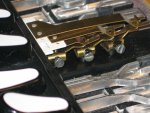I acquired an Excelsior Model 272E recently in order to try PAs again.
It is a decent instrument....probably too Pigini for me on reflection...and one that seems unused.
But, having soon discovered that the PA keyboard reintroduced the mechanical stress that I had avoided by a change to buttons, I placed the accordion for sale on Ebay.
I have had to close the listing early because, in answering a question posed about the instrument with a recording on Soundcloud, it was pointed out that in the MM register another reed (L) can be heard ghosting in some notes (upper octave).
I will not re-list until I have corrected this anomaly but Im not sure where to start looking.
Is it likely to be incorrect register slide adjustment?
I attach some images and a sound bite of the problem and would be very grateful for opinion.
These are the register tabs :
This is the mechanism.
It is a decent instrument....probably too Pigini for me on reflection...and one that seems unused.
But, having soon discovered that the PA keyboard reintroduced the mechanical stress that I had avoided by a change to buttons, I placed the accordion for sale on Ebay.
I have had to close the listing early because, in answering a question posed about the instrument with a recording on Soundcloud, it was pointed out that in the MM register another reed (L) can be heard ghosting in some notes (upper octave).
I will not re-list until I have corrected this anomaly but Im not sure where to start looking.
Is it likely to be incorrect register slide adjustment?
I attach some images and a sound bite of the problem and would be very grateful for opinion.
These are the register tabs :
This is the mechanism.







